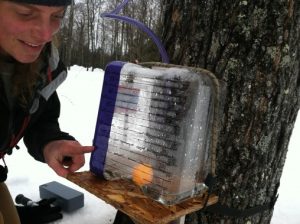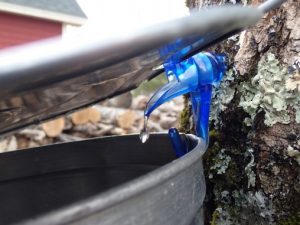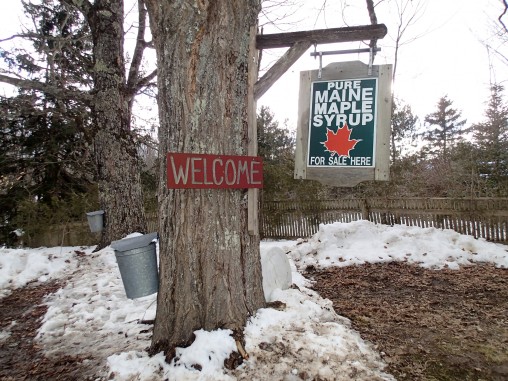The Future of Sugar Maples in Maine
Not all winters are created equal. This past season brought record low temperatures along with a menu of snow, sleet, and ice. The severity and length of winter has always been variable, but new emphasis on a changing climate brings a need to understand the effects of these conditions on the species here in Maine.

UMaine graduate student Jenny Shrum is studying changes in the phenology of maples and the resulting effects on syrup production. If Sugar Maples alter their life stages for changing conditions, producers will also need to adjust. Shrum seeks to determine the connection between specific weather conditions, such as the temperature or amount of precipitation, and the rate of sap flow in Sugar Maple trees. Current models can predict days of expected sap flow, but are unable to quantify the amount. Shrum’s research will look for factors in the air and soil that may increase or decrease the tree’s flow rate. With a better understanding of the relationships between factors, it may be possible to predict future flow based on environmental measurements.
Traditionally, winter in Maine has brought a snow pack that covers the ground for the duration. Accumulated snow traps air that helps to insulate the ground. In this way, winds can bring an Arctic chill to the air, but the ground will only freeze to an inch or less. If climate change predictions for a lighter snow pack in New England are realized, forests will lose this extra blanket of insulation. Ironically, warmer winters with less snow will actually result in a deeper ground freeze. Not only does this cause a temporary decrease in available groundwater, it also increases the potential for damage when ice forming in the soils cuts tree roots.

Although many climate change predictions do not suggest a complete loss of Maine’s Sugar Maples in the next 100 years, the timing and quantity of sap flow may change, affecting syrup production. Sap is a mix of water and sugars that the tree uses for energy. In the spring, thawing air temperatures start sap movement from the trunk, towards the branches. At the same time, tree roots take in available water. Although the range of Sugar Maples extends south of New England, tapping of the trees only occurs in the colder portion of its range where overnight lows and daytime warming freeze and thaw the sap, extending the syrup season.
Long-term records show that tapping is happening earlier, even though there is considerable variation from year to year. However, Shrum warns that the answer may not be as straightforward as tapping earlier because of biological constraints. For example, after the initial spring thaw, a tree must have the opportunity to refreeze and to absorb moisture from the soil. In a warming climate, the potential for a deeper ground freeze and fewer freeze/thaw events during the spring would each contribute to a shorter season. Furthermore, spring warmth that creates an earlier sap flow also speeds the emergence of leaves from their buds. The resulting chemical changes from budburst alter the flavor of the sap in an unpleasant way, so an earlier leaf-out could also shorten the season.
Finally, Shrum’s research recognizes that social constraints will contribute to the future of Maine’s syrup production. Many producers have embraced technology to increase efficiency and yield, but whether they will be able to embrace a new inconsistent schedule is unknown. The 2012 season came early and passed quickly. It was followed by a good production season in 2013. Early reports from this year suggest that a harsh winter delayed the first thaw and a quick spring warm-up has virtually ended the season. An unpredictable sap flow may lead to questions of schedule availability for syrup producers, affecting future production.
Few local species have the ecological, economic, and cultural importance of the Sugar Maple. A model that connects the amount of sap flow to weather and soil conditions could provide insight into possible future changes. Increasing our understanding of factors that influence Maple phenophases will allow producers to use the best practices, ensuring syrup production in Maine for years to come.

